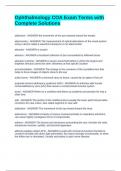Exam (elaborations)
Ophthalmology COA Exam Terms with Complete Solutions
- Course
- Institution
Ophthalmology COA Exam Terms with Complete SolutionsOphthalmology COA Exam Terms with Complete Solutionsabduction - ANSWER-the movement of the eye outward toward the temple. aberrometry - ANSWER-The measurement of optical aberrations of the visual system using a device called a wavefront ananlyz...
[Show more]



